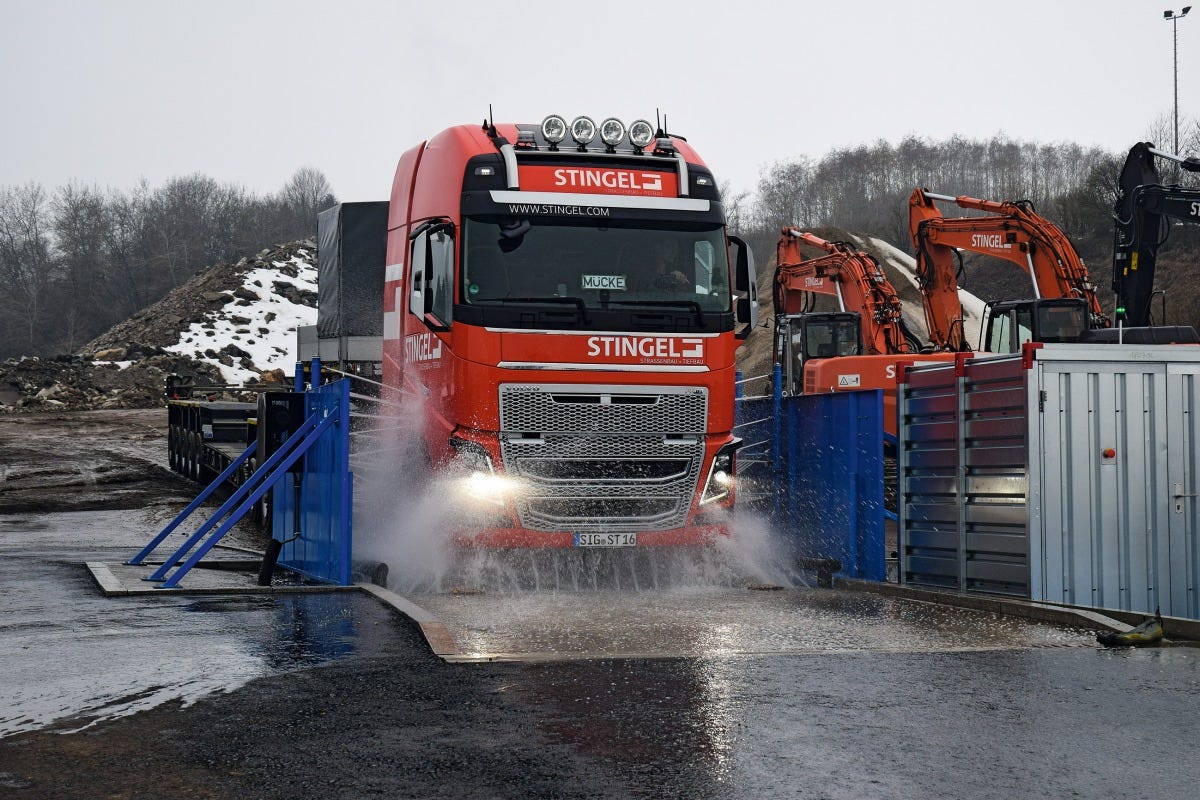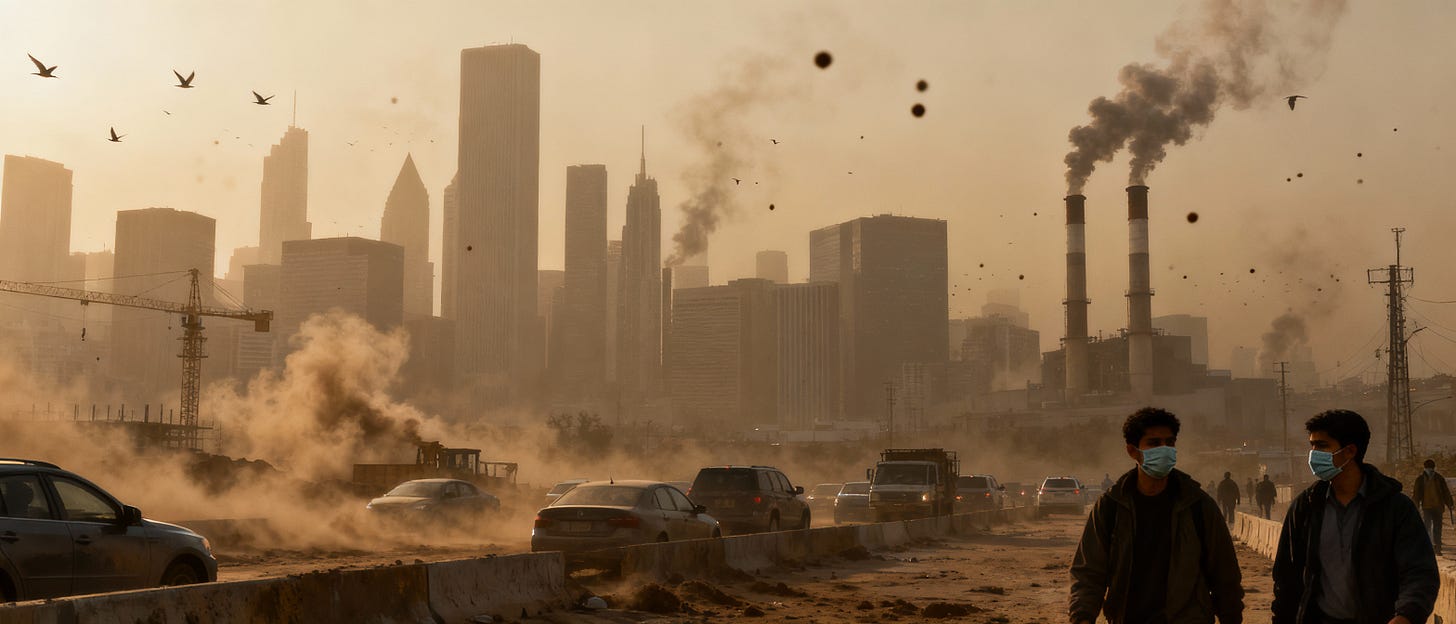Understanding urban pollution.
Delhi's poor air quality arising from stubble burning in adjoining states in making headlines. So this is a good opportunity to understand urban air quality in more detail. Lets dive in.
Urban air quality is big driver of quality of life. Like every year, this year too Delhi’s air quality dropped substantially in winter. The major contributor to this well understood to be the stubble burning in neighbouring states of Punjab and Haryana. This problem is confined to the North down-wind areas from Punjab and Haryana.
However, in other parts of India too people have noticed something. If you look at the telecast of cricket matches in India and compare them to those in England or Australia you will see a lot of difference. This difference should not be visible in photos (since they go through photoshop corrections) but it is still evident. The reason is air quality.


Understanding Air Quality
Air quality depends upon the following factors:
The chemical composition of air (the gas pollutants)
These include various gases such as :
Nitrogen Oxides (NOx, including NO and NO2) NOx are major contributors to urban smog and acid rain. In cities, they primarily come from combustion processes in power plants, industrial facilities, and heating systems. Domestic fossil fuel use for cooking or heating also adds to levels, especially in densely populated areas. These gases can react with VOCs to form ground-level ozone.
Sulfur Dioxide (SO2) SO2 is a pungent gas that leads to respiratory problems and contributes to acid rain, damaging buildings and ecosystems. Urban sources include coal-fired power plants, industrial processes like metal smelting, and oil refining. In some cities, the use of residual fuel oil for shipping or heating exacerbates this issue.
Carbon Monoxide (CO) is an odourless, toxic gas that reduces oxygen in the blood and is particularly dangerous in enclosed urban spaces. Key sources include incomplete combustion from industrial boilers, waste incineration, and household appliances such as gas stoves or heaters.
Ground-Level Ozone (O3). Unlike stratospheric ozone, ground-level O3 is a secondary pollutant formed by reactions between NOx, VOCs, and sunlight in urban heat. It irritates the lungs and worsens asthma. Urban contributors include emissions from solvents, paints, and industrial activities that release precursor chemicals.
Volatile Organic Compounds (VOCs) are a diverse group of chemicals that evaporate easily and contribute to ozone formation and indoor/outdoor pollution. In cities, they’re released from consumer products like paints, cleaning agents, adhesives, pesticides, printing inks, and personal care items (e.g., perfumes, cosmetics). Industrial evaporation and leaks from storage tanks are also significant sources of concern.
Other Hazardous Air Pollutants (HAPs or Air Toxics) include substances such as benzene, formaldehyde, polycyclic aromatic hydrocarbons (PAHs), lead, and heavy metals (e.g., arsenic). They cause cancer and other serious health effects. Urban sources encompass industrial emissions, waste burning, and chemical manufacturing. Lead, although reduced, can still come from legacy sources, such as old paint or batteries.
Ammonia (NH3). Often overlooked, NH3 contributes to the formation of secondary aerosols and eutrophication. In urban areas, it’s emitted from waste decomposition, sewage treatment, and agricultural activities on city fringes, as well as some industrial processes.
The physical composition of air
These include the actual particulate matter termed as suspended particulate matter (SPM) and can be classified as:
Dust and heavy particulates (heavier can settle down but easily resuspended by wind). These are not inhalable, but they pose other risks, including to the eyes and ears.
Coarse Particles (PM10 or Thoracic Particles): These have diameters of 10 μm or less (but larger than 2.5 μm). They are inhalable and can lodge in the upper respiratory tract, such as your nasal hair or mucus. If a higher percentage of these particles is present, it clogs the nasal passage, causes throat irritation and/or a burning sensation. Common sources include road dust, construction debris, agriculture, and wind-blown soil. Dust from these activities often dominates this category.
Fine Particles (PM2.5 or Respirable Particles): Diameters of 2.5 μm or less. These can penetrate deep into the lungs and even enter the bloodstream, posing greater health risks like cardiovascular and respiratory diseases. While finer dust (e.g., from combustion or industrial processes) contributes, this category encompasses more from secondary atmospheric formation.
Ultrafine Particles (PM0.1 or Nanoparticles): Diameters of 0.1 μm (100 nanometers) or less. These are the smallest, often from combustion sources, and can cross into the brain or other organs. Dust rarely falls here, as it’s typically coarser, but ultrafine dust can form from mechanical grinding or vehicle wear.
Most Indian cities have a problem with dust!
The problem in most Indian cities is not the noxious gases. Instead, it is dust - both from human and natural sources.
Construction and Demolition Activities: Dust is generated from excavation, building, demolition, and material handling at construction sites. This is a significant source of coarser PM10 particles in growing urban areas.
Industrial Processes: Factories and manufacturing facilities release dust through emissions from the burning of fossil fuels, chemical reactions, and material processing, often containing toxic elements such as heavy metals.
Power Generation: Coal-fired power plants and other energy production sites emit fine particulates from combustion and smokestacks, contributing significantly to urban PM levels.
Household and Domestic Combustion: Burning solid fuels, such as wood, charcoal, coal, or kerosene, for cooking, heating, or lighting in homes releases substantial amounts of particulate matter, especially in densely populated areas.
Waste Management and Burning: The open burning of municipal waste or agricultural residues near urban fringes, along with dust from landfills and waste handling, contributes to airborne particulates.
Raw Material Stockpiles: Wind-scattered dust from uncovered stockpiles of materials (e.g., near ports, factories, or construction yards) contributes to fugitive dust in industrial zones.
Consumer Products and Volatile Compounds: Everyday items like cleaning agents, paints, cosmetics, and perfumes release volatile organic compounds (VOCs) that can react in the atmosphere to form secondary particulate matter.
Wind-Blown Soil and Crustal Dust: Erosion of exposed soil, unpaved surfaces, or dry earth in urban green spaces or outskirts, resuspended by wind, forms a baseline of natural particulates.
Biological and Pollen Particles: Naturally occurring pollen, spores, and plant debris in city parks or along streets can contribute to organic dust, especially during certain seasons.
Geological Events: Rare but impactful sources like volcanic ash (from distant eruptions) or thunderstorm-generated dust can occasionally affect urban air.
Natural location: There is an ecological reason for the high prevalence of dust in Indian cities. India is located within a “desert zone” that lies between 15 and 30 degrees latitude. Hence, India experiences a very concentrated rainy season between June and October. The rest of the year is bright and sunny, which dries the moisture from the soil. This means, unlike other countries, India will have to work harder to ensure there is no soil-generated dust.
The Solutions

Construction and Demolition Site Management: Construction is a primary source of coarse dust (PM10). Key controls focus on minimising fugitive emissions:
Dust Suppression Techniques: Utilise water sprinklers, mist cannons, or chemical suppressants (e.g., polymers) on exposed surfaces and during excavation operations. Enclose sites with barriers or tarps to contain particles.
Material Handling Protocols: Cover stockpiles of sand, gravel, or debris; limit vehicle speeds on-site; and clean wheels before exiting to prevent road resuspension. In cities like Los Angeles, mandatory wetting and covering have reduced local dust by up to 70%.
Phased Scheduling and Permits: Require permits that mandate dust control plans, with phased work to minimise exposed areas. Fines for non-compliance encourage adherence.
Road and Traffic Dust Suppression: Road dust from unpaved surfaces and vehicle movement contributes significantly to urban PM.
Paving and Maintenance: Pave unpaved roads with asphalt or permeable materials; apply gravel or stabilisers to rural-urban fringes. Regular street sweeping and vacuuming remove accumulated particles.
Vegetative Barriers: Plant roadside hedges or grass to trap dust; maintaining vegetation cover reduces exposed soil erosion.
No uncovered open soil: Uncovered open soil dries out quickly and, along with the wind, adds to the particulate matter in the air.
Industrial and Waste Management Controls: Industries and waste burning release fine particulates (PM2.5) alongside dust.
Emission Control Technologies: Install filters, such as baghouses or electrostatic precipitators, on stacks; switch to low-emission processes or fuels. Chimneys require proper emission management systems. Relocating heavy industries from city centres, as in China’s eastern cities, has helped.
Waste Collection Improvements: We will need covered garbage bins and high-quality garbage trucks to effectively manage waste collection.
Waste Processing Improvements: Ban open burning and promote recycling and waste-to-energy initiatives. Covering landfills and using leachate controls prevent dust from waste sites.
Parali-processing power plants: Buy the crop stubble from the farmers and use it as a fuel for thermal energy generation. The plant should be able to use gas as an alternative fuel and should be equipped with bag filters and carbon scrubbing technology.
Zoning and Standards: Enforce zoning laws to separate industrial zones and establish strict emission limits, utilising real-time monitoring with IoT sensors connected to SMART City control rooms for seamless tracking and compliance.
Transportation and Vehicle-Related Measures: While focusing on non-exhaust PM (e.g., tyre/brake wear, road dust), these reduce overall particulates.
Electrification and Clean Fuels: Shift to electric vehicles (EVs) and buses, which produce less brake dust; phase out diesel in public fleets. Cities like Shenzhen have electrified transport to lower PM.
Reduce stand-still traffic spots: The more vehicles stand still on the road, the more the SPM emissions. Common bottlenecks are traffic signals, toll booths and roadworks.
Urban Planning and Greening Initiatives: Design cities to naturally mitigate dust and PM.
Green Infrastructure: Create urban forests, green roofs, and parks to absorb particulates—trees can filter up to 30% of local PM. Vertical gardens and “green corridors” enhance this in dense areas.
Building and Ventilation Design: Utilise wind mapping to optimise building layouts, enhancing airflow and reducing pollutant concentrations; incorporate carbon-capturing materials into structures.
Sustainable Land Use: Minimise soil disturbance through compact development and protect natural buffers, such as wetlands, ponds, and lakes.
6. Household and Indoor Controls: Indoor sources contribute to outdoor PM via ventilation.
Green Energy Transitions: Replace solid fuels (wood, coal) with gas, electricity, or renewable sources for cooking/heating, reducing ambient SPM.
Cleaning conventional energy: Carbon scrubbing and carbon capture technologies must be deployed in industries that use coal, wood, or oil for fuel.
Policy, Monitoring, and Community Engagement: Overarching frameworks ensure sustained impact.
Regulatory Incentives and Restrictions: All of these ideas require regulation and strong enforcement. As a corollary, we will need dispute resolution mechanisms and corruption control.
Advanced Monitoring Networks: A certain amount of fact collection can be augmented using sensors to gather real-time data on PM hotspots; utilise AI and smart traffic lights to dynamically adjust flows.
Public Awareness and Collaboration: Ultimately, public awareness and engagement can drive more effective enforcement.
In Sum
Urban pollution is a multi-dimensional problem. India has taken many steps in improving the chemical composition of air. Yes, more can be done but substantial progress has already been achieved in this area.
However, we need to focus our attention on Suspended Particulate Matter (SPM) levels and we need to tackle this challenge in all our cities.
Note:
For detailed references you can email me.



